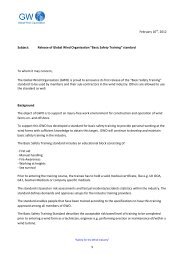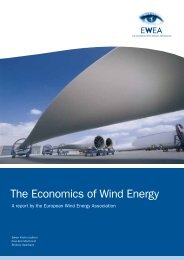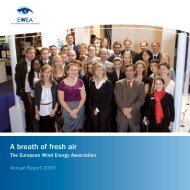Offshore Electricity Infrastructure in Europe - European Wind Energy ...
Offshore Electricity Infrastructure in Europe - European Wind Energy ...
Offshore Electricity Infrastructure in Europe - European Wind Energy ...
Create successful ePaper yourself
Turn your PDF publications into a flip-book with our unique Google optimized e-Paper software.
esults<br />
4.2.4 Conclusion and discussion on<br />
hubs versus <strong>in</strong>dividual connections<br />
Cluster<strong>in</strong>g of w<strong>in</strong>d power projects is advantageous <strong>in</strong><br />
many cases, depend<strong>in</strong>g on the distance from shore<br />
and the concentration of <strong>in</strong>stalled capacity <strong>in</strong> the<br />
same area. A shared hub connection is most advantageous<br />
when the sum of <strong>in</strong>stalled w<strong>in</strong>d power capacity<br />
<strong>in</strong> a small area is relatively large and equal to standard<br />
available HVDC voltage source converter (VSC)<br />
systems.<br />
For distances from the onshore connection po<strong>in</strong>t of<br />
up to about 50 km, usually 50 Hertz HVAC technology<br />
is used and hubs do not generally provide much<br />
added value due to limited sav<strong>in</strong>gs <strong>in</strong> cable length. For<br />
larger distances, the best solution depends primarily<br />
on the total available w<strong>in</strong>d farm capacity <strong>in</strong> the area<br />
that could be grouped <strong>in</strong>to the hub. For long distances<br />
to shore a hub connection is mostly beneficial; the<br />
benefit <strong>in</strong>creases with distance.<br />
Integrat<strong>in</strong>g a w<strong>in</strong>d farm <strong>in</strong>to a nearby hub is economically<br />
advantageous for w<strong>in</strong>d farm to hub connection<br />
distances of less than 20 km. For greater w<strong>in</strong>d farm<br />
to hub connection distances the benefit will be rapidly<br />
reduced. However, if the hub’s size is large and<br />
if it is located far from shore, this aga<strong>in</strong> improves<br />
the economics. For w<strong>in</strong>d farm to hub connection distances<br />
beyond 40 km, no beneficial hub cases were<br />
identified.<br />
In view of the large potential benefits of connect<strong>in</strong>g<br />
w<strong>in</strong>d farm clusters via hubs, political and regulatory<br />
strategies to foster their development are of primary<br />
importance.<br />
Additional considerations<br />
The above assessment is solely based on economic<br />
considerations. In cases where the hub is less beneficial,<br />
decision makers may still opt for hub solutions <strong>in</strong><br />
order to mitigate the environmental and social impact<br />
of cable lay<strong>in</strong>g through environmentally sensitive or<br />
highly frequented coastal areas. A hub solution may<br />
also allow more efficient logistics dur<strong>in</strong>g construction.<br />
Time delay costs and stranded<br />
<strong>in</strong>vestments<br />
It has to be highlighted that a hub project is <strong>in</strong> general<br />
more complex. Construction schedules of w<strong>in</strong>d farms<br />
<strong>in</strong> a certa<strong>in</strong> area seldom co<strong>in</strong>cide. The economic assessment<br />
is based on their connection schedules. If<br />
projects that are supposed to be connected are abandoned,<br />
the overall hub costs <strong>in</strong>crease significantly due<br />
to stranded <strong>in</strong>vestments or longer transition times<br />
with oversized cables that are only partly loaded.<br />
However, the case study analysis for a hub connection<br />
of three w<strong>in</strong>d farms with a capacity of 350 MW each<br />
has shown that the costs of such delays or stranded<br />
<strong>in</strong>vestments should not be overestimated. In the case<br />
study the hub solution rema<strong>in</strong>s economically viable up<br />
to a 10 year time delay for two of the w<strong>in</strong>d farms to<br />
be connected. Even if the one of the w<strong>in</strong>d farms is<br />
not built at all, the hub connection is the preferred<br />
solution.<br />
Where hub connections are clearly shown to be beneficial,<br />
a dedicated regulatory and policy framework to<br />
mitigate this risk will be required. The risk of stranded<br />
<strong>in</strong>vestment can be mitigated, e.g., by strategic sit<strong>in</strong>g<br />
and concessions with the specific aim of hav<strong>in</strong>g groups<br />
of projects with a capacity of 1,000 to 2,000 MW per<br />
group concentrated <strong>in</strong> an area and developed approximately<br />
at the same time.<br />
4.3 Integrated design –<br />
case studies<br />
This section elaborates on the <strong>in</strong>tegration of w<strong>in</strong>d<br />
farm hubs and <strong>in</strong>terconnectors, the ma<strong>in</strong> idea beh<strong>in</strong>d<br />
the offshore grid <strong>in</strong> the North Sea. The <strong>Offshore</strong>Grid<br />
project focuses on two major design concepts. Any offshore<br />
grid design can be broken down <strong>in</strong>to these two<br />
fundamental build<strong>in</strong>g blocks:<br />
• Tee<strong>in</strong>g-<strong>in</strong> of w<strong>in</strong>d farms <strong>in</strong>to <strong>in</strong>terconnectors (jo<strong>in</strong>tly<br />
developed with the w<strong>in</strong>d farms or already exist<strong>in</strong>g)<br />
as shown <strong>in</strong> Figure 4.9.<br />
• Interconnection of countries via w<strong>in</strong>d farm hubs on<br />
either side as shown <strong>in</strong> Figure 4.10.<br />
42 <strong>Offshore</strong>Grid – F<strong>in</strong>al Report









